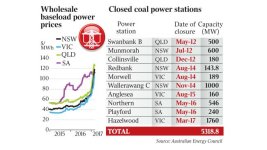Hillhater
100 TW
yes, i found similar data for the daily usage profile.
regarding generating costs, it hard to get solid reliable data, but if you assume the info in that " eia" table is not too distorted , then you can crunch some rough comparisons for construction and operating costs for new plant..
https://www.eia.gov/analysis/studies/po ... table1.xls
Strangely, the variable operating costs ( fuel mainly) are not the biggest factor, but capital/installation costs amortized over the operating lifespan are much more influential on the final unit cost.
you have to make some assumptions as to the effective useful operating life, but there is info around for existing coal and gas systems. ( 30 -40 years) ... Solar and Wind are more of a guess with limited data, but 20 years would be a good run for that technology.
you also have to remember to compare equivalent output capacity ..GWh/yr and include whatever storage costs that may require.
My own "back of the envelope" estimates put the Gas CC systems well down at or below 2c/kWh,
..and Solar + storage up at 5+ c/kWh
I suspect there are many in government and influential positions who do not have a good understanding of the hard facts.
EDIT .. just picked up your linked video..
I guess the summary is you can get away with solar without storage , providing you have enough conventional supply to fill in when renewable s are not available ! ..
regarding generating costs, it hard to get solid reliable data, but if you assume the info in that " eia" table is not too distorted , then you can crunch some rough comparisons for construction and operating costs for new plant..
https://www.eia.gov/analysis/studies/po ... table1.xls
Strangely, the variable operating costs ( fuel mainly) are not the biggest factor, but capital/installation costs amortized over the operating lifespan are much more influential on the final unit cost.
you have to make some assumptions as to the effective useful operating life, but there is info around for existing coal and gas systems. ( 30 -40 years) ... Solar and Wind are more of a guess with limited data, but 20 years would be a good run for that technology.
you also have to remember to compare equivalent output capacity ..GWh/yr and include whatever storage costs that may require.
My own "back of the envelope" estimates put the Gas CC systems well down at or below 2c/kWh,
..and Solar + storage up at 5+ c/kWh
I suspect there are many in government and influential positions who do not have a good understanding of the hard facts.
EDIT .. just picked up your linked video..
I guess the summary is you can get away with solar without storage , providing you have enough conventional supply to fill in when renewable s are not available ! ..


